21 Real-Life Marketing Personalization Examples to Learn From

According to our Personalization Pulse Check Report, 58% of consumers are frustrated with brands that offer generic and inconsistent communication. To grab customers’ attention, you need to offer them unique experiences that they are able to connect with.
Regardless of the industry you’re operating in, personalization is the key to attracting and acquiring customers, as well as building deep, long-lasting relationships that foster engagement and retention.
One of the best ways to build an effective strategy is to learn from personalized marketing examples of industry-leading brands and then optimize your campaigns to increase conversion and customer lifetime value.
In this article, we’ll help you learn how to do that across various industries (such as Retail and Ecommerce, Quick Service Restaurants, Financial Services, and Media and Entertainment) by covering different types of personalized marketing and showing real-life examples that you can integrate into your own marketing strategy.
What is Personalization in Marketing?
Personalization in marketing is a customer engagement strategy focused on crafting highly personal experiences and marketing campaigns that drive engagement, brand loyalty, and conversions.
Personalized marketing relies heavily on customer segmentation, customer activity, behavioral data, and other insights to understand customer needs and interests.
Marketers then use this information to create unique experiences and messaging across different but interconnected channels, that resonate with customers. This can include crafting dynamic, tailored web and in-app experiences, web and mobile push notifications, email and SMS messages, and more.
Types of Personalized Marketing
Personalized marketing isn’t just about slapping a customer’s name on an email or SMS — it’s about delivering unique experiences and messaging that resonate with your customers. And that can take many different forms across a myriad of channels.
Below, we explore common types of personalization strategies and techniques companies use to deliver tailored marketing campaigns.
- Segmentation-based personalization: Identify similarities between customers based on interests and preferences, transactional activity, recency of purchase, frequency of purchase, and other customer activity. Then build segments and run tailored campaigns for each segment.
- Event-triggered personalization: Automatically trigger onsite messaging, emails, mobile push notifications, and other communication based on specific customer activities and events (for example, cart abandonment, price drop, or if the customer hasn’t opened the app in a certain number of days) to connect them with the right message, at the right time.
- Real-time personalization: Respond to customer behavior and intent in real-time, activating personalized messaging and advertising that understand customer intent.
- Omnichannel personalization: Using interconnected channels to create seamless customer experiences that connect with customers via their preferred channels, This increases traction and engagement, maximizing each available touchpoint with your audience.
- AI-based personalization: Maximize customer engagement by using AI that automatically optimizes customer journeys, message copies, and customer experiences in real-time based on customer behavior, customer activity, and use case.
By using a combination of personalization tactics, marketers are able to create a personalized marketing strategy that fits their industry; whether that’s retail and ecommerce, QSR and food delivery, banking and financial services, or media and entertainment.
Top Channels for Delivering Personalized Marketing
Personalized marketing isn’t isolated to one method of communication. It can be done across a myriad of channels simultaneously to maximize engagement and impact.
Below, we look at the best channels for sending personalized marketing messages to your customers and subscribers.
- Website: Online experiences shouldn’t be stagnant and boring, they should provide customers with unique experiences using dynamic content and product recommendations that are sent to the customer via customized on-site messaging or web push notifications.
- Email: A staple of any customer engagement strategy, email marketing campaigns help you nurture leads, advertise products and services, offer promotions and discounts, and share brand news and updates.
- Mobile App: Customers who install apps are already committed on a level that website visitors might not be. But to keep them interested you need to provide personalized in-app experiences and messaging that utilize effective communication.
- Push Notifications: Most consumers keep their phones relatively close, so a mobile push notification is sure to get their attention. It’s great for activating customers with urgent messages that require a timely response or action.
- SMS: One of the most direct lines of communication, personal messaging has some of the highest view and open rates.
- Social Media: Consumers spend a lot of time on social media, and it’s become a great avenue for advertising. Personalized ads are a great way to differentiate yourself from the competition and attract customers.
Despite the overall effectiveness of personalized marketing campaigns, different strategies and channels are effective for different industries, brands, and use cases. It’s important to experiment with various tactics while honing in on what’s having the greatest impact.
So, with that in mind, we’ve included 21 examples of personalized marketing from B2C brands grouped by industry to inspire your strategy.
21 Examples of Personalized Marketing Campaigns That Drive Customer Engagement
While personalization is often aimed at the same core objectives of increasing customer engagement and retention, this is done in very different ways across different industries:
- Retail & Ecommerce brands are focused on driving conversions and increasing average order values.
- QSR & Food Delivery companies are focused on fostering loyalty and increasing repeat orders, as well as increasing order values through upselling and cross-selling.
- Banks & Financial Institutions are focused on upselling customers on new products and convincing them to invest more of their money with the institution.
- Media & Entertainment brands are focused on driving engagement with their content and increasing subscriptions, whether their audience is watching, listening, or reading.
To help you apply different personalized marketing strategies effectively in your industry, below, we’ll explore examples from leading brands, looking at how they deploy effective personalized marketing campaigns that drive results.
Retail & Ecommerce Personalization Examples
As noted, retail and ecommerce companies are focused on the bottom line — sales. Personalization is an ideal strategy for improving customer engagement, leading to increased average order values (AOV), customer lifetime values (LTV), and overall revenue.
Below, we take a look at some of the most effective examples of personalization in ecommerce and retail:
1. Shein uses customer segmentation to offer targeted product recommendations
Leading online retailers are constantly devising ways of getting products in front of customers, allowing them to create cross-sell and upsell opportunities.
Like many B2C retailers, Shein uses customer segmentation to group customers based on their shopping history and style preferences.
The “Customers Also Viewed” category allows them to provide recommendations based on what products similar customers have engaged with or purchased.

- Why This Is an Example of Personalization: The product recommendations the customer receives are all curated based on the customer segment that they belong to, so all recommendations are tailored to fit their interests and style.
- Why This Is So Successful: Not only do these recommendations provide cross-selling opportunities, they encourage customers to keep shopping, even if the first item they looked at didn’t quite hit the mark. This tactic of immediately serving customers with similar product recommendations keeps them engaged and increases their AOV.
2. Amazon uses personalized product recommendations to create cross-selling opportunities
To effectively cross-sell and upsell, you need to be able to market the right products at the right time. In many cases, this is best done while a customer is shopping.
When a customer has added an item to their cart, Amazon will automatically recommend products that are “Frequently bought together”. These real-time recommendations are triggered based on insights such as what product combinations other similar customers have ordered, promoting a product that is related to that customer’s immediate purchase.

- Why This Is an Example of Personalization: Product recommendations are triggered in real-time when a customer adds an item to their cart, and the recommendations themselves are personalized according to the item that has been added to the cart.
- Why This Is So Successful: Serving customers contextually relevant product recommendations in real-time significantly increases the success of cross-selling efforts, time spent in-app, and the AOV.
3. Google Play Books serves targeted discounts and promotions
Google Play Books automatically triggers an email and mobile push notification to inform the customer when an item on their wishlist has had a price drop.

- Why This Is an Example of Personalization: The recommendation is based on what the customer already has on their wishlist, and which they’ve already shown an interest in. By specifically promoting items the customer has shown buying intent for, you increase the likelihood of a conversion.
- Why This Is So Successful: Providing relevant discounts and promotions are far more likely to result in a conversion. More importantly, providing discounts for items customers have already shown clear buying intent improves the customer experience, increasing satisfaction and retention. Lastly, it is a great strategy to entice price-conscious customers, as it reduces any monetary friction in the buying journey.
4. Old Navy cross-sells with intelligent on-site messaging
Web experiences are far more effective when on-site messages are tailored to the customer’s preferences and behavior.
Old Navy uses real-time on-site messaging that recommends products based on what the customer is currently shopping for.
Specifically, they suggest fashionable pairings that match the item the customer is looking at. Rather than diverting the customer to a new item, they create a cross-sell opportunity, enticing the customer to purchase a product in an entirely different category than they were originally looking at.

- Why This Is an Example of Personalization: Recommendations are generated in real-time, based on the item the customer is currently looking at and their historical shopping behavior, enabling marketers to deliver engaging on-site experiences that suit the customer’s style.
- Why This Is So Successful: Providing contextually relevant on-site messaging improves the website shopping experiences, increases engagement, and drives conversions. When done right, it also creates cross-selling and upselling opportunities that let you increase AOV and LTV.
5. Walmart uses location data to provide dynamic, omnichannel content and experiences
If you’re going to send customers mobile push notifications that demand their attention, you need to make sure these messages push them down the funnel to where they shop.
Walmart uses customer segmentation to serve geographically relevant flyers to customers with weekly deals. These are communicated to them via strategically-timed, personalized push notifications and are made dynamic to ensure customers are always served relevant promotions based on where they’re currently located.
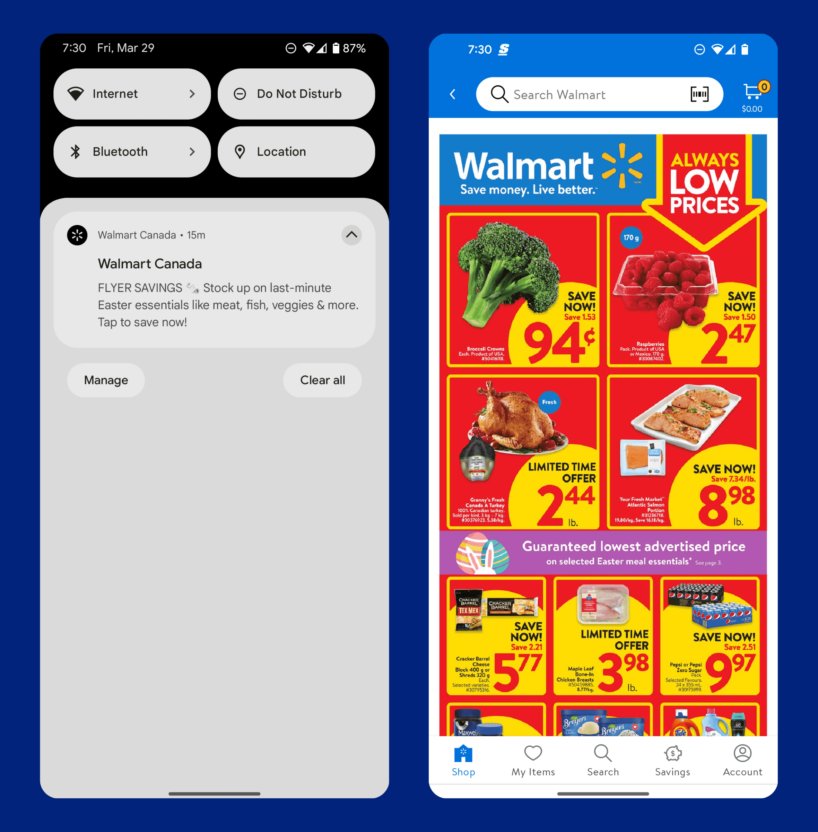
- Why This Is an Example of Personalization: For these flyers to be relevant, they need to account for the customer’s geographic location and linked to a push notification that brings the customer to open the app. They also need to be timed according to when the promotions advertised are active; too late and the customer will have already missed out; too early and the customer will forget about it by the time it rolls around.
- Why This Is So Successful: Providing customers with dynamic content through customizable HTML templates in the mobile app and using channels like push notifications to bring them in ensures that the entire experience is seamless and caters to the customer’s shopping behavior.
Examples of QSR Personalization
QSR and food delivery companies rely heavily on repeat buyers. It isn’t just about getting a single conversion, it’s about fostering brand loyalty that translates into long-term engagement and increased order volumes and values. So they focus far more on building loyalty through rewards programs and omnichannel marketing, which engages customers via their preferred channel and real-time.
Below, we cover real-life examples of how QSR companies and food delivery brands use personalized marketing to improve engagement and order volumes.
1. Domino’s uses targeted mobile push notifications to increase sales
Domino’s personalizes the content of their mobile push notifications to promote deals based on the customer’s previous orders on the app, website, or in-store.
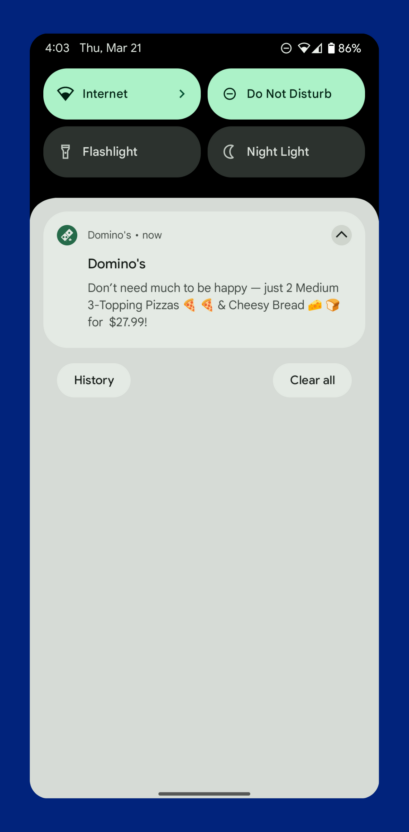
- Why This Is an Example of Personalization: The offer being promoted has been selected based on the customer’s order history and frequently purchased items, instead of offering a random promotion. The timing of the notification itself is personalized based on when the customer is most likely to order.
- Why This Is So Successful: Sending promotion-based communication on products the customer regularly orders and at the optimal time drastically increases click-through rates, engagement, and orders.
| Learn how MoEngage helped Domino’s clock 20% uplift in revenue via its loyalty program and multiple automated, hyper-personalized customer journeys. |
2. Starbucks uses mobile push to promote time-sensitive offers
Restaurants often serve limited-time items on their menu, and in some cases, these items are also only available in certain locations. Similarly, pricing can vary in different locations and different time of the day (such as peak hours vs. non-peak hours). It’s imperative that the marketed price lines up with what the customer pays.
Starbucks uses mobile push notifications to promote time-sensitive offers that customers need to jump on fast to take advantage of. These are done to encourage the customers to visit during non-peak hours (i.e. 12pm – 6pm).
First, a mobile push is sent the day before, making the customer aware of the offer (and allowing them to potentially think about how they can work a visit into their day). On the day of the limited-time offer, another mobile push notification is sent to remind them that the offer ends soon (giving them enough time to get out and take advantage of the offer). 
- Why This Is an Example of Personalization: First, geographic location data is used to ensure that the offer is available in the customer’s area. Next, the timing of the message is customized to the customer’s time zone, the time frame of the offer, the optimal time for an interaction, and eating preferences. This helps to customize the touchpoints with the buyer, thus pushing them down the conversion funnel.
- Why This Is So Successful: If the mobile push is served after the offer is valid, it not only fails to convert, it will actually pester and disappoint the customer. It’s imperative that the offer is communicated at the right time to foster engagement. Furthermore, limiting the time range of the offer validity ensures that Starbucks continues to earn revenue evene during non-peak hours.
3. Uber Eats recommends active deals with mobile push notifications
Uber Eats sends personalized mobile push notifications addressed directly to the customer to get their attention. As advertised, when clicked it funnels customers to restaurants nearby that are currently offering deals, helping them find a restaurant with a great deal and encouraging them to place an order.

- Why This Is an Example of Personalization: The mobile push notification itself is timed based on when the customer is most likely to place an order, depending on their buying history. The recommendations are also curated based on deals that are active in the customer’s local area and on restaurants that serve the preferred cuisine.
- Why This Is So Successful: Providing recommendations that aren’t available in the customer’s location or lie outside the customer’s preferences don’t just fail to hit the mark, they can actually lead to churn. On the contrary, personalized recommendations that fit the customer’s needs/preferences have a higher click-through rates and lead to more conversions.
4. Domino’s funnels high-intent buyers directly to the checkout using mobile push notifications
Domino’s often sends personalized mobile push notifications, recommending the customer’s favorite orders at great prices. When clicked, this pulls customers into an orchestrated customer journey within the app, guiding them to finish ordering the items advertised.
This guided, omnichannel strategy connects with customers at the optimal time, pulling them into the app, followed by a curated in-app experience that results in conversions.

- Why This Is an Example of Personalization: The entire customer journey — from the mobile push notification, to in-app experience, to checkout — is orchestrated for the customer, built entirely around a personalized offer. The in-app experience is crafted specifically for the purchase, saving the customer time by swiftly moving them through to the checkout page.
- Why This Is So Successful: A personalized mobile push notification offers a relevant product to the customer at the optimal time, increasing click-through rates. The guided experience funnels customers closer to checkout, streamlining the shopping process, saving the customer time, and making it more convenient for them to complete their order.
5. Starbucks optimizes rewards program enrollment with targeted in-app lead-nurture campaigns
Effective personalized marketing campaigns aren’t just focused on putting your products and services in front of customers, they also get them to become active members that engage with your brand on a regular basis, and eventually become brand loyalists.
Starbucks uses in-app messaging to provide an orchestrated experience that educates customers on how to use the app to manage their Starbucks Rewards account. This entire in-app sequence is designed to nurture the lead to subscribe, familiarizing them with the rewards program (including the sign up and redemption process, and benefits). By the time the customer reaches the end of the nurture sequence — and are required to sign up and input their credentials — they’re already primed to participate.

- Why This Is an Example of Personalization: This orchestrated journey is only triggered for customers who have already shown an interest in the rewards program by clicking to join. This event-based trigger ensures that only high-intent customers are funneled into this lead nurture sequence, which markets the Starbucks Rewards program to them.
- Why This Is So Successful: By filtering only high-intent customers into this in-app sequence, Starbucks increases participation in the program and improves early adoption and activation of rewards members. This ensures prospective rewards members are served this messaging at the optimal time, increasing enrolment in the program and activating users early.
6. SkipTheDishes streamlines the onboarding process with orchestrated customer journeys
Like Starbucks, SkipTheDishes also funnels new app users into an orchestrated customer journey that familiarizes them with their rewards program and teaches them how to navigate the app. This pulls new users into a guided experience with in-app messaging that points out various components of the app, so it’s extremely easy for customers to learn how to become (active) participants.

- Why This Is an Example of Personalization: This orchestrated journey is only triggered for customers who have never used the app before or have recently installed the app after not using it for a long time. This ensures that this onboarding orchestration is only initiated for customers that need to learn how the app works and avoids bogging down other cohorts with this sequence.
- Why This Is So Successful: Onboarding orchestration is a great way to provide guided experience for new users. In this case, an onboarding experience familiarizes customers with the rewards program and teaches them how to use the app, improving the customer experience, satisfaction, and app stickiness.
7. Uber Eats uses in-app messaging to promote offers
Uber Eats uses seamlessly integrated in-app messaging to promote discounts and offers to customers while they are browsing. This serves customers contextually relevant ads while customers are shopping on the app, allowing them to easily accept the offer with a single click.

- Why This Is an Example of Personalization: The promotion is only served to customers on restaurants that match their preference in terms of cuisine, location, delivery time, rating, etc.
- Why This Is So Successful: The in-app messaging is seamlessly integrated in the customer journey, making it easily accessible to the customer. Since customers are already browsing in the app, they likely have an intent to buy. Capitalizing on that intent with a targeted offer drastically increases engagement and conversions.
8. McDonald’s orchestrates rewards onboarding with an omnichannel welcome campaign
When a new customer joins their MyRewards program, McDonald’s automatically triggers an omnichannel welcome campaign across various channels, designed to teach the customer how the rewards program works and convince them to become a regular visitor. The entire campaign aims to build an initial rapport with customers, enticing them of the benefits of using the rewards program. This is done by sending personalized messaging on channels such as email, mobile push notifications, and in-app messaging.
After the customer has signed up via the app, a welcome email is sent to them. A day or two later, McDonald’s follows up this communication with a mobile push notification designed to activate the customer via the welcome offer. This eventually brings the customer back in the app or in-store, fostering engagement, conversion, and retention.
The result is a fully curated, streamlined onboarding process that ensures customers are familiar with the program and how it works. This encourages customers to engage and actively participate, ideally hooking them into being an active rewards member who collects and spends points.
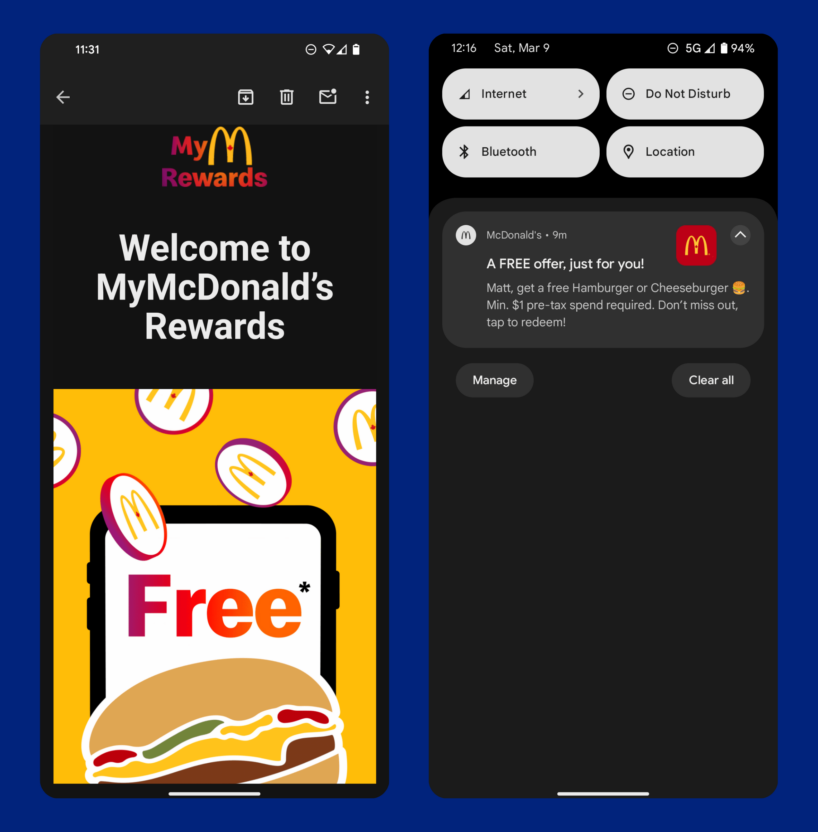
- Why This Is an Example of Personalization: This event-triggered marketing campaign targets new customers who have recently enrolled, providing them with a curated experience that nurtures them to become active rewards members, and offers them a free item based on what’s popular in their geographic location.
- Why This Is So Successful: The entire sequence is designed to seamlessly onboard customers to the rewards program, from explaining how the app works, to a free reward that encourages conversion. By the end, the customer knows how to use the rewards program in real life, encouraging a seamless experience.
Examples of Personalization in Banking
Consumers are protective of their finances — and rightly so. Banks and financial institutions don’t just need to sell a product, they need to convince customers to trust them with their finances.
There are few things more personal than people’s finances, so it’s only right that personalized marketing is the most effective way to show customers you understand them and have their best interests, and confidentiality at heart.
Below, we look at some examples of personalized marketing in banking and finance.
1. Wealthsimple recommends products based on customer insights
Wealthsimple prompts app visitors and customers with personalized product recommendations that facilitate cross-selling. By intermittently reminding the customer when they enter the app on other products they can use (such as a ‘managed investing account’, Wealthsimple engages the customer when they are already thinking about their finances and are most likely to convert.

- Why This Is an Example of Personalization: The investment account being recommended is based on products the customer currently has, their transaction activity, and their general behavior. The message itself is also only served intermittently, so the customer doesn’t have to see the message every time they open the app.
- Why This Is So Successful: Customers don’t open bank accounts the same way they purchase retail products. They convert a lot less frequently and often put more thought into what products they want. Serving targeted products that fit the customer’s immediate needs and connect at the right time drastically increases engagement and conversions.
2. TD Bank leverages omnichannel marketing to cross-sell effectively
After a customer buys tickets for a flight using a credit card linked to a TD bank account, an email is automatically sent to the customer, promoting the TD Travel Insurance. This event-triggered email ensures that the communication the customer receives is contextually relevant. It also saves them time shopping for a product TD Bank knows they need, creating a great cross-selling opportunity!
![TD Bank sends personalized emails to cross-sell effectively]](https://www.moengage.com/wp-content/uploads/td-personalized-cross-sell-recommendation-1.png)
- Why This Is an Example of Personalization: The email itself is automatically triggered based on customer activity, ensuring it’s timed effectively to increase engagement and conversion. The communication is also personalized based on the recent transactional activity of the customer, making it contextually relevant.
- Why This Is So Successful: First and foremost, TD is offering a product they know the customer is in the market for — and are therefore interested in. By streamlining the pathway to that product, they make themselves the first option the customer thinks of. More importantly, it gives TD Bank a chance to cross-sell a product before the customer goes to a competitor.
3. Ally Bank leverages an omnichannel approach to engage customers
Ally Bank’s omnichannel approach is driven by creating unified customer profiles that provide a holistic view of their customers. This allows them to truly understand what their customers want, and reach out to customers with the right promotions, at the right time, and on the right channels.
For e.g. Ally Bank uses email drip campaigns that connect with customers at different touchpoints throughout their customer journey, ensuring customers remain engaged at every stage of their financial lifecycle (acquisition, welcome, cementing, cross-sell, win-back, etc.).
Ally also sends automated service alerts to customers to optimize their experience, notifying customers when checks clear, deposits are made, or fraud is detected. These are communicated via orchestrated journeys involving channels like emails, SMS, mobile push notifications, and in-app messages. This omnichannel approach helps Ally enhance customer interactions, drive engagement, and improve CLV.
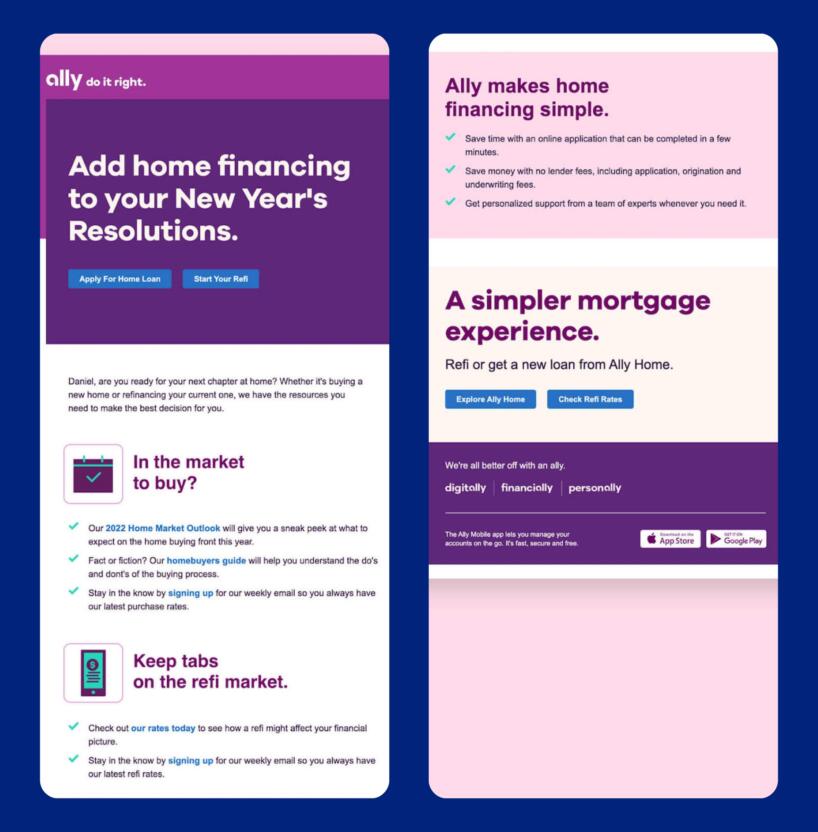
- Why This Is an Example of Personalization: Relying on customer insights has helped Ally target the right promotions to the right customers, at the right time and on the preferred channels.
- Why This Is So Successful:The service alerts are timely, relevant, actionable, and delivered through the customers’ preferred channels to increase trust and mitigate risk. Also, the omnichannel strategy aligns with the customers’ financial lifecycle journey and enhances customer interaction, driving app and web engagement.
Entertainment & Media Marketing Personalization Examples
One of the biggest goals for media and entertainment marketers is to increase the time customers spend watching, listening, and reading content on their app/website; after all, that’s what drives subscriptions and renewals.
Below, we look at personalized media marketing examples from leading media and entertainment brands.
1. Netflix serves hyper-personalized content recommendations
Netflix is a leader in the video streaming industry, and it’s not just because they offer some of the best content; it’s also because they excel at curated personalized experiences that promote their content effectively.
Netflix creates completely curated lists based entirely on customer’s viewing and watch history, content ratings, items added to “My List,’ and other in-app activity. More than just sorting content into traditional categories like “Comedy” and “Action”, they create custom lists for their subscribers based on what they know they’ll love, like “Top Picks for You,” “We Think You’ll Love These,” and “Because You Watched X.”
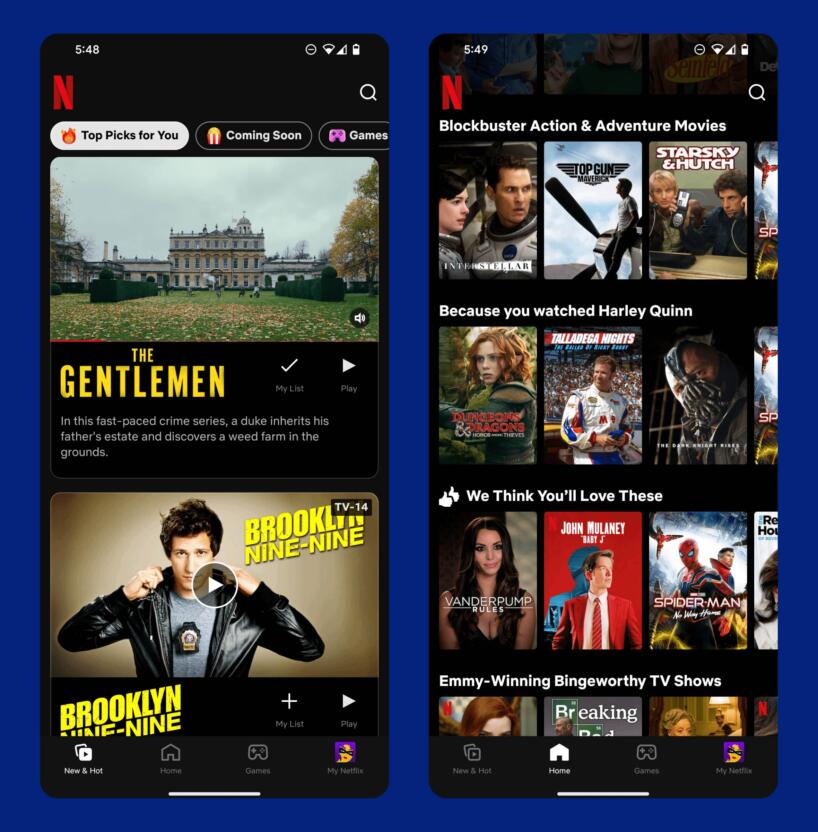
- Why This Is an Example of Personalization: Individual content recommendations, as well as entire lists, are curated entirely based on the customer’s previous browsing/watch history, ratings, reviews, and overall in-app behavior. Recommendations are hyper-personalized, with each individual receiving a fully customized experience, along with match percentages for content.
- Why This Is So Successful: The entire experience is curated for each individual subscriber, so they can access the content they are most interested in as quickly and easily as possible. Promoting relevant content increases time in-app, watch time, and renewals. This increases the CLV in the long-term.
2. Spotify increases time in-app with personalized marketing
After the customer listens to a new artist for the first time, Spotify automatically triggers a mobile push notification promoting that artist’s biography. This urges the subscriber to follow the artis’s page and get notified when new songs and album are launched. This personalized marketing strategy not only increases the customer’s time in-app but also gets them to keep coming back to the app.

- Why This Is an Example of Personalization: The recommendation itself is personalized to the listener, and is based solely on previous listening activity and behavior. The mobile push notification is also event-triggered: It’s timed based on the customer having recently listened to an artist for the first time.
- Why This Is So Successful: This strategy increases listening time, time spent in-app, subscriptions, and renewals.
3. Netflix reactivates customers with personalized mobile push notifications
Netflix sends a targeted mobile push notification to alert the customer that there are new episodes available to watch, encouraging them to continue watching a series they’ve watched before. It also sends customers reminders to complete watching the video they had been watching.
In fact, the mobile push notifications offer customers three different call to actions: WATCH (watch the show right now in app), DOWNLOAD (download the episodes to watch them later), and MY LIST (add them to their watchlist to consume later). All three buttons bring the customer in the app, increasing click-through rates and engagement rates.
This is an ideal way to reactivate dormant or inactive customers, drawing them in with targeted content recommendations. More simply, it’s an ideal method of increasing watch time and time spent in the app.

- Why This Is an Example of Personalization: The content recommendation is based on the customer’s previous viewing activity. The language of the message is also tailored to reflect their previous behavior, which speaks more directly to them (and resonates more with them).
- Why This Is So Successful: By promoting content the customer has already shown an interest in and has previously interacted with, drastically increases click-through and engagement rates. This further increases time in-app, all while providing the customer an optimized experience that quickly and conveniently connects them with their favorite content.
4. Flipboard connects readers with the content they care about through a curated in-app experience
Sometimes the best way to give your customers exactly what they want is to ask them.
During onboarding, Flipboard asks customers what categories of content they are most interested in, so that they can serve focused, targeted content that engages the customer. As soon as onboarding is complete and the customer is in-app, they’re served personalized content based on the categories they care about. The user interface is also curated to make these categories easier to find in the navigation, so that the customers can get to the content that matters quickly. Flipboard also asks customers to share their location, in order to serve them with local news and other updates.
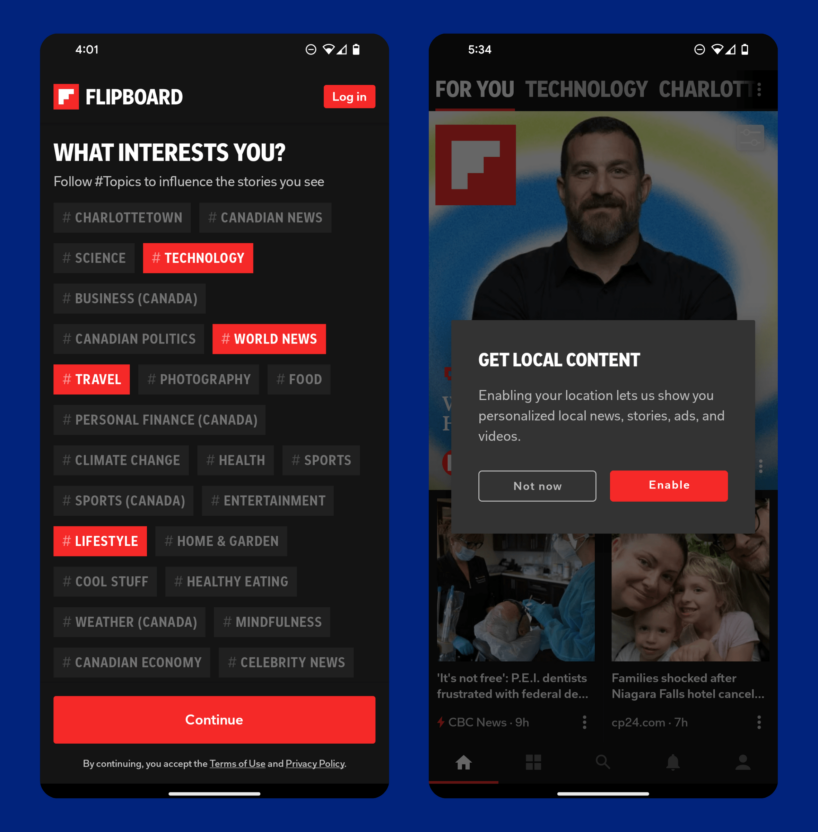
- Why This Is an Example of Personalization: The content customers see and categories available in the app menu are personalized based on the topics customers choose during onboarding and their geographic location. Over time, Flipboard is also able to use customer insights to further tailor the content recommendations for each individual reader.
- Why This Is So Successful: Providing the reader with relevant articles increases readership, time in-app, and active engagement. This increases daily active users (DAUs) and helps drive subscriptions and renewals.
5. PGA Tour builds customer loyalty to market future subscriptions and sales
Effective marketing isn’t just about driving an immediate sale, sometimes it’s about improving satisfaction and nurturing leads to convert over time.
The PGA Tour app is a marketing tool designed to sell network subscriptions, event tickets, and brand merchandise. And it does this by providing a seamless, customized in-app experience that connects fans with the scores, event coverage, and top news they care about.
The curated leaderboard has quick-click options that signal when a player on the list can be viewed on a broadcast, and an embedded link makes it extremely easy for a customer to find — and subscribe — to that broadcast.
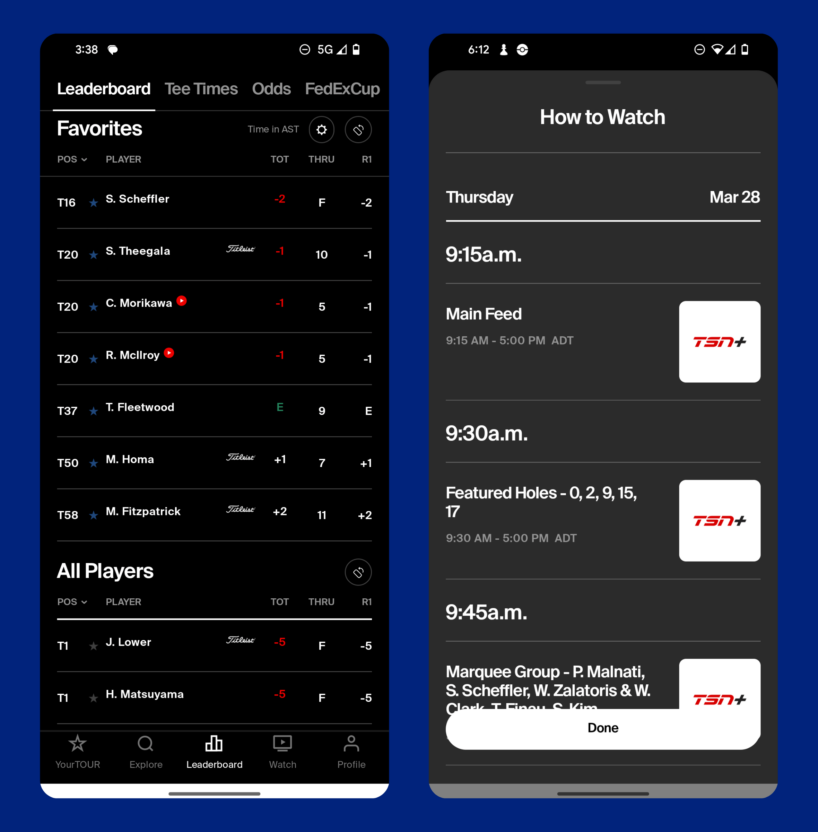
- Why This Is an Example of Personalization: The leaderboard customers see is curated based on the players they choose to follow, giving fans a personalized experience when following live events, tracking standings, and consuming content.
- Why This Is So Successful: With a personalized leaderboard, fans can follow the players they care about most. By providing links to live broadcasts featuring that player, they increase click-through rates, network subscription sales, and time spent in the app.
| Learn how to media and entertainment brands can scale their customer engagement strategy. |
Empower Marketing Personalization with MoEngage
Since customers want to shop from brands that understand them and provide them curated recommendations, personalized marketing is the key to attracting, acquiring, and retaining them.
Personalized marketing helps in developing deep, meaningful relationships with customers that improve engagement and retention, fostering true brand loyalty that lasts. At the end of the day, this translates into conversions, subscriptions, and revenue.
While different strategies will be useful in different industries, for the greatest impact, brands will need to use a combination of personalized marketing strategies such as those suggested above.
MoEngage’s software helps B2C companies deliver personalized experiences that resonate with customers no matter the industry. You can craft dynamic personalized marketing that delivers tailored product recommendations to effectively cross-sell and upsell, focused in-app messaging that nurtures leads, mobile push alerts that activate dormant customers and increase overall engagement, and more.
Our enterprise-ready customer engagement platform helps retail and ecommerce businesses drive conversions and increase order values, QSR and food delivery companies build loyalty and increase repeat orders, banks and financial institutions upsell products and gain customer trust, and media and entertainment companies increase engagement with content.
Schedule a demo today to learn how we can take your personalized marketing strategy to the next level.














